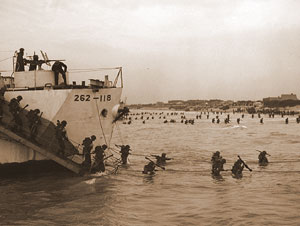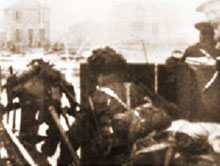Bénouville and Pegasus Bridge
D-Day for Canada
Juno Beach - June 6, 1944
On D-Day, Canada landed 14,000 troops of the 3rd Canadian Infantry Division on Juno Beach. D-Day for Canada also involved the Royal Canadian Air Force which bombed and attacked key enemy targets, while the Royal Canadian Navy contributed 109 vessels and 10,000 sailors to the massive armada of 7,000 Allied vessels. On D-Day, Canada's assault troops landed on Juno Beach and stormed ashore in the face of fierce opposition from German strongholds and mined beach obstacles. The soldiers raced across the wide-open beaches swept with machine gun fire, and stormed the gun positions. In fierce hand-to-hand fighting, they fought their way into the towns of Bernières, Courseulles and Saint-Aubin and then advanced inland, securing a critical bridgehead for the allied invasion. The victory was a turning point in World War II and led to the liberation of Europe and the defeat of Nazi Germany.

Fourteen thousand young Canadians stormed Juno Beach on D-Day. Their courage, determination and self-sacrifice were the immediate reasons for the success in those critical hours. The fighting they endured was fierce and frightening. The price they paid was high - the battles for the beachhead cost 340 Canadian lives and another 574 wounded.
Juno beach was five miles wide and stretched on either side of the small fishing port of Courseulles-sur-Mer, France. Two smaller villages, Bernières and Saint-Aubin, lay to the east of Courseulles. The coastline had been fortified by the occupying Germans and bristled with guns, concrete emplacements, pillboxes, fields of barbed wire and mines.
Canadian soldiers
The 3rd Canadian Infantry Division reinforced by the 2nd Canadian Armoured Brigade landed in two brigade groups:
- 7th Brigade consisting of the Royal Winnipeg Rifles, Regina Rifles, and Canadian Scottish regiments,
- 8th Brigade consisting of the North Shore Regiment, Queen's Own Rifles, and Le Régiment de la Chaudière.
Each Brigade group was comprised of 3 infantry battalions (regiments), and supported by an armored regiment, 2 artillery field regiments, combat engineer companies and extra units such as Armored Vehicles, Royal Engineers (AVRE's). The Fort Garry Horse tanks (10th Armored Regiment) supported the 7th brigade landing on the left and the1st Hussars tanks (6th Armored Regiment) supported the landing on the right.
The 9th Brigade consisting of the Highland Light Infantry, Stormont Dundas and Glengarry Highlanders, and North Nova Scotia Highlanders regiments landed from 11.33 to 11.50 in 17 minutes and advanced through the lead brigades. The Sherbrooke Fusiliers tanks (27th Armored Regiment) provided tank support.
Although a total of 14,000 Canadians stormed Juno Beach on D-Day, there were not more than three thousand young Canadians in the first wave - all ranks. The initial assault was the responsibility of four regiments with two additional companies supporting the flanks:
- North Shore Regiment on the left at Saint-Aubin (Nan Red beach),
- Queen's Own Rifles in the centre at Bernières (Nan White beach),
- Regina Rifles at Courseulles (Nan Green beach),
- Royal Winnipeg Rifles on the western edge of Courseulles (Mike Red and Mike Green beaches),
- a company of the Canadian Scottish secured the right flank,
- a company of British, Royal Marine Commandos secured the left flank.

Canadian wave
The first wave of Canadian infantry was brought into shore by LCA's landing at 7:55. When the ramps lowered the troops disembarked and waded ashore. The soldiers hit the beaches and began the deadliest run of their lives. As they worked their way through the obstacles and minefields they came into the killing zones of the German gun positions. The assault troops raced across the beaches through the curtain of machine gun fire, rushed the pillboxes and eliminated the German strong-points with Sten-guns, small arms fire and grenades. The first wave took heavy casualties on the beaches. DD tanks arrived on the beaches and fired on the pillboxes, decimating the remaining strong-points. In bitter hand-to-hand fighting the Canadians cleared the enemy gun positions and fought their way into the towns.
All morning long the battle raged along the precious strip of coast. The Regina Rifles and Royal Winnipeg Rifles fought their way through Courseulles and Graye-sur-Mer. The North Shore Regiment captured Saint-Aubin while the Queen's Own Rifles took the town of Bernières. Tanks and infantry struck inland all that day and pressed on through villages, fields and groves of trees defended by determined Germans.
Facing formidable gun emplacements, machine gun nests and snipers, the brave Canadian soldiers did not hesitate in their advance. Determined officers led their well trained platoons to take out the enemy strongholds. Countless times the soldiers showed acts of valor by engaging the enemy in vicious close quarter fighting. Soldiers lost their close friends in the fighting and somehow found the courage to keep going. Through the terror of the battle the disciplined soldiers pushed on to overcome the enemy positions. The fierce battles were won by the bravery of the individual Canadian soldiers and the collective actions of their regimental units.